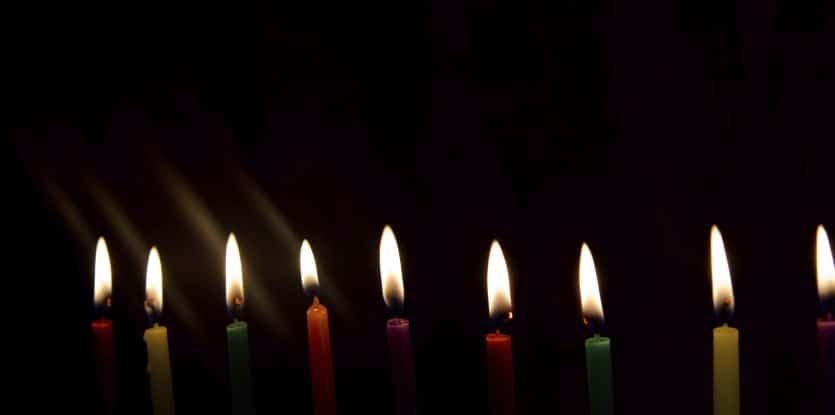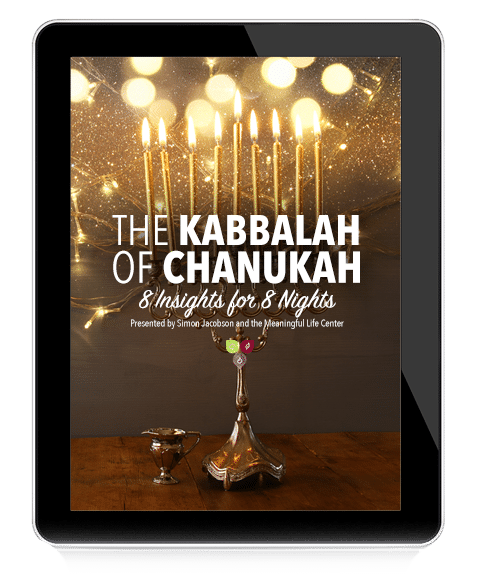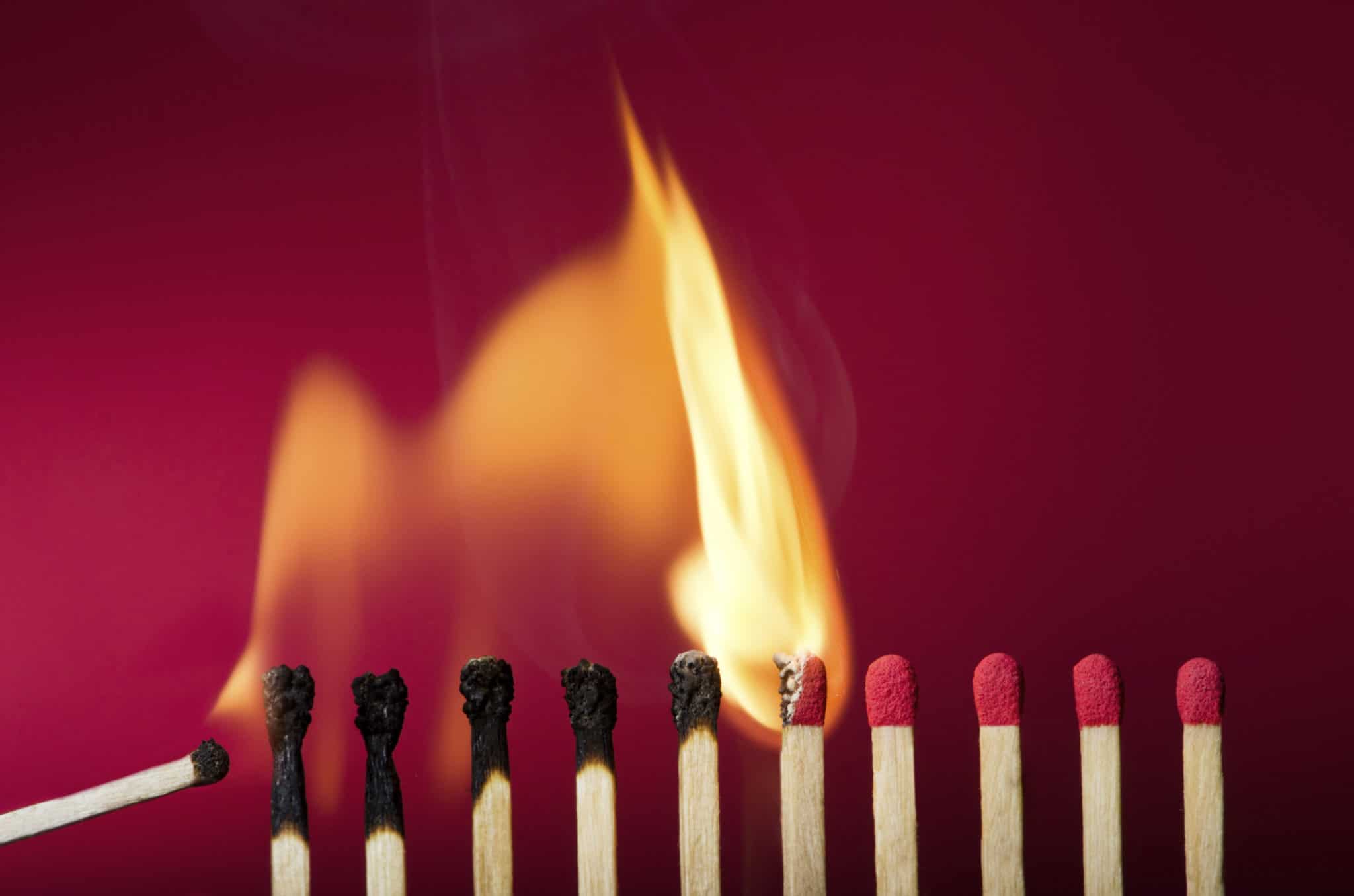Unlike most other mitzvot, which can be (and usually are) performed indoors, the laws governing the kindling of the Chanukah lights stipulate that they be placed within the doorway or window of the home, so that their luminance should radiate outward to the street. The night may be dark, the street may be teeming with alien and commonplace elements, but if there is a Jewish home in the vicinity, the street will know that it is Chanukah.
It will also know which night of Chanukah it is. On each of the eight nights of Chanukah, a different number of flames are kindled, expressing that night’s particular place in the festival. On the first night of Chanukah, there will be one flame illuminating the street; on the second night, two flames; and so on.
Actually, the Talmud records two opinions on how each Chanukah night should identify itself and cast its unique light upon the world. This was one of the halachic issues debated by the two great academies of Torah law, the House of Shammai and the House of Hillel: the sages of Hillel held that the Chanukah lights should increase in number each night, in the familiar ascending order; the sages of Shammai were of the opinion that eight flames should be lit on the first night, seven on the second, and so on in descending number, until the eighth night of Chanukah, when a single flame should be lit.[1]
The Talmud explains that the sages of Shammai saw the Chanukah lights as representing the “upcoming days” of the festival—the number of days still awaiting realization; thus, the number of lights decrease with each passing night, as another of Chanukah’s days is “expended.” The Hillelian view, on the other hand, sees the lights as representing Chanukah’s “outgoing days,” so that the ascending number of flames reflect the accumulation of actualized milestones in the eight-day quest for light.
In practice, we follow the opinion of the school of Hillel, and an ascending number of lights chronicle the progress of the festival. This is even alluded to in the very name of the festival: the Hebrew word “Chanukah” forms an acronym of the sentence Chet Neirot V’halachah K’veit Hillel—”Eight lights, and the law follows the House of Hillel.”[2]
Our acceptance of Hillel’s perspective on Chanukah is also expressed by the name traditionally given to the eighth day of Chanukah—the only day of the festival to be distinguished by a name of its own—“Zot Chanukah.”
The name “Zot Chanukah” is based on a phrase from that day’s Torah reading, and literally means “This is Chanukah.” This is in keeping with the Hillelian vision of Chanukah, in which the final day of Chanukah—the day on which all eight days of light have been actualized—marks the climax of the festival; only on the eighth day can we say: “This is Chanukah; now we ‘have’ the entire Chanukah.” (From the Shammaian perspective, the first day of Chanukah would be “Zot Chanukah.”)
What is the basis for these two visions of Chanukah? And why is the view of the House of Hillel so overwhelmingly embraced, to the extent that it is implicit in the very name “Chanukah” and in the name given to its culminating day?
The Debate
There are two basic ways in which one might view something: in light of its potential, or its actual state. We might say of a certain person: “He has tremendous potential, but his actual performance is poor.” The same can be said of a corporation, a relationship, an experience, or anything else. Or we might say: “There’s potential for disaster here, but it might be contained and prevented from actualizing.”
Some of us are potential-oriented, which means that we would admire the person, invest in the company, stick it out with the relationship and treasure the experience—depending upon its potential. Some of us are more actual-oriented, viewing things in terms of their “bottom line”—their actual tactual impact upon our reality.
This is a recurring theme in many of the disputes between the schools of Shammai and Hillel. For example, the sages of Shammai consider the moment of the Exodus to be the eve of Nissan 15, when the people of Israel were free to leave Egypt; the sages of Hillel place the moment at midday of the following day, when the Jews actually exited Egypt’s physical borders.[3] In another debate, the sages of Shammai consider a fish susceptible to ritual impurity from the moment the fisherman pulls his catch out of the water, since at this point the fish has been removed from the environment in which it might possibly live; the sages of Hillel disagree, contending that as long as the fish is actually alive (though its potential for continued life has been destroyed), it is immune to contamination, as are all other living plants and animals.[4]
This is also the basis of their differing perspectives on Chanukah. The House of Shammai, which views things in terms of their potential, sees the first day of Chanukah, with its potential for eight days of light, as the point in which all eight days are “there”; but after one day has “gone by” and passed from potential into actuality, we “have” only seven days in their most meaningful form—the potential form. The sages of Hillel, on the other hand, see the actual state as the more significant; to them, the eighth day of Chanukah, when all eight dimensions of the festival have been actualized, is when the festival is at its fullest and most “real.”
G-d’s Reality
We are creatures of the actual. We cannot live on potential nourishment, or be emotionally satisfied by potential relationships; on the whole, we judge people by their actual conduct, as opposed to their potential to behave a certain way. Reality, to us, is what is, not what might be.
This is largely due to the fact that we are physical beings. It is a most telling idiom of our language that “immaterial” means “insignificant”: if we cannot touch it or see it, it’s not real to us. Also, because of our finite and limited nature, we possess potentials that we will never actualize because we haven’t enough energy, resources or willpower to carry them out, or simply because we won’t live long enough to do so. So the existence of a potential or possibility for something is not enough, for how do we know that it will amount to anything? Indeed, we often tend to view the actual as the measure of potential: if this much has been actualized, this “proves” that there is potential worthy of regard.
Envision, however, a being who is neither physical nor finite; a being not limited by space, time or any other framework. In such a being, potential does not lack actualization, for everything is “as good as done.” On the contrary: potential is the purest and most perfect form of every reality—the essence of the thing, as it transcends the limitations and imperfections imposed upon it when it translates into physical actuality.
For G-d, then, the potential is a higher form of being than the actual. This is why we say that, for G-d, the creation of the world did not constitute an “achievement” or even a “change” in His reality. The potential for creation existed in Him all along, and nothing was “added” by its translation into actuality. It is only we, the created, who gained anything from the actual creation of the world.
So when the sages of Shammai and Hillel debate the question of which is more significant from the perspective of Torah law, the actual or the potential, they are addressing the more basic question: Whose Torah is it—ours or G-d’s? When the Torah enjoins us to commemorate the Exodus, when it legislates the laws of ritual impurity or commands us to kindle the Chanukah lights, does it regard these phenomena from the perspective of its divine author, in which the potential is the ideal state, or from the perspective of its human constituency, which equates actual with real?
The Torah
Whose Torah is it, ours or G-d’s? Both Shammai and Hillel would agree that it is both.
The Torah is the wisdom and will of G-d. But as we proclaim in the berachah (benediction) recited each morning over the Torah, G-d has given us His Torah, for He has delegated to mortal man the authority to interpret it and apply it. Thus, He did not communicate His will to us in the form of a detailed manifesto and a codified list of instructions. Instead, He dictated a relatively short (79,976-word) “Written Torah” (the Five Books of Moses), together with the “Oral Torah”—a set of guidelines by which the Written Torah is to be interpreted, decoded, extrapolated, and applied to the myriads of possibilities conjured up by the human experience.
So while the entire body of legal, homiletic, philosophical and mystical teaching we know as “Torah” is implicit within the Written Torah, G-d designated the human mind and life as the tools that unlock the many layers of meaning and instruction contained within its every word.
Torah is thus a partnership of the human and the divine, where a kernel of divine wisdom germinates in the human mind, gaining depth, breadth and definition, and is actualized in the physicality of human life. In this partnership, our human finiteness and subjectivity become an instrument of the divine truth, joining with it to create the ultimate expression of divine immanence in our world—the Torah.
Which is the more dominant element of Torah—divine revelation or human cognition? Which defines its essence? What is Torah—G-d’s vision of reality, or man’s endeavor to make his world a home for G-d? At times the Torah indicates the one; at times, the other. Thus we have the rule that “The words of Torah are not susceptible to contamination.”[5] A person who is in a state of ritual impurity (tum’ah) is forbidden to enter the Beit HaMikdash (Holy Temple); but there is no prohibition for him to study Torah. Why is he forbidden to enter a holy place but permitted to think and speak holy words? Because the Torah is not only “holy” (i.e., an object subservient to G-d and receptive to His presence)—it is divine. It is G-d’s word, and the divine cannot be compromised by any impurity.
On the other hand, another law states that “A teacher of Torah who wishes to forgive an insult to his honor, can forgive it.”[6] This is in contrast to a king, who if insulted, has no right to forgive the insult, and no recourse but to punish the one who insulted him. For a king’s honor is not his personal possession, but something that derives from his role as the sovereign of his people; one who insults the king insults the nation, and this is an insult that the king has not the authority to forgive. Yet does not one who insults a Torah scholar insult the Torah? How does the scholar have the right to forgive the Torah’s insult? The explanation given is that “the Torah is his.”[7] He who studies Torah acquires it as his own; G-d’s wisdom becomes his wisdom.
Whose Torah is it—ours or G-d’s? Both descriptions are valid; both are part of the Torah’s own self-perception. In certain laws and circumstances, we find the divinity of Torah emphasized; in others, its human proprietorship.
Thus, in a number of laws, the schools of Shammai and Hillel debate which definition of Torah is the predominant one. The sages of Shammai believe that in these particular applications of Torah law, the divinity of Torah predominates: the Torah’s perspective is synonymous with G-d’s perspective, meaning that the potential of a thing is its primary truth. The Sages of Hillel see these laws as belonging to the “human” element in Torah, so that Torah’s vision of reality is the human, actual-based perspective.
The Human Festival
In the great majority of the disputations between the schools of Shammai and Hillel, the final halachic ruling follows the opinion of the House of Hillel. Halachah is the application of Torah to day-to-day life. In this area of Torah, it is the human element which predominates; here, reality is defined in terms of the actual and tactual, rather than the potential.
But nowhere is the supremacy of the Hillelian view more emphasized than in the debate on Chanukah, where the very name of the festival, and the name given to its final day, proclaim that “the law follows the House of Hillel.” For Chanukah is the festival that, more than any other, underscores the human dynamic in Torah.
As noted above, the Torah consists of two parts: the divinely dictated words of the Written Torah, and the Oral Torah, also communicated by G-d, but delegated to man. In the Oral Torah, G-d provides the guidelines and principles, while man follows theses guidelines and applies these principles to derive and express the divine will.
The Oral Torah has two basic functions: to interpret the Written Torah, and to legislate the necessary laws, ordinances and customs required to preserve the Torah and Jewish life through the generations.
Most of the festivals are explicitly ordained in the Written Torah. This is not to say that there is no “human element” involved: the Oral Torah is still required to clarify each festival’s laws and observances. For example, the Written Torah commands us to dwell in a sukkah and take the Four Kinds on Sukkot, but the Oral Torah is needed to interpret the oblique biblical allusions that tell us how a sukkah is to be constructed and which plant species are to be taken. Yet the festivals themselves were instituted by direct divine revelation.
There are two festivals, however, that are rabbinical institutions: Purim and Chanukah. These belong to the second function of the Oral Torah: to institute laws and observances that derive not from a verse in the Written Torah, but which arise out of the historical experience of the people of Israel.
These, too, are Torah, for they were enacted in accordance with the principles revealed at Sinai. Before reading the megillah on Purim, or kindling the Chanukah lights, we say: “Blessed are You, G-d… Who has sanctified us with His commandments, and commanded us to read the megillah… to kindle the Chanukah lamp.” G-d is commanding us to observe these mitzvot, for it is He who granted the leaders of each generation the mandate to institute laws, ordinances and festivals. Yet in these festivals, it is the human element of Torah which predominates, while the divine element is more subdued.
Of the two rabbinical festivals, Chanukah is even more “human” than Purim. Purim was instituted during the Era of Prophecy, when G-d still communed directly with the greatest individuals of the generation. The story of Purim was written down and incorporated within the Holy Scriptures that are appended to the Written Torah. Thus, while Purim is technically an “Oral Torah” festival, it is closely related to the Written Torah.
Chanukah, however, occurred several hundred years later, when prophecy had ceased and the canon of the twenty-four books of the Tanach (Bible) had been closed. It thus belongs wholly to the Oral Torah—to the predominantly human element of the partnership. So Chanukah is the environment in which the Hillelian perspective on Torah—Torah as it relates to our tactual experience of the world we live in—reigns supreme.
Based on the Rebbe’s talks on Chanukah 5740 (1979) and Tevet 4, 5733 (December 9, 1972)[8].
Adapted from the teachings of the Lubavitcher Rebbe by Yanki Tauber.
[1]. Talmud, Shabbat 21b.
[2]. Avudraham, Seder Hadlakat Ner Chanukah.
[3]. The question of the precise moment of the Exodus has certain halachic repercussions, such as the procedure for reciting hallel on the seder night. See Talmud, Pesachim 116b; Jerusalem Talmud, Pesachim 10:5; Rashi on Deuteronomy 16:1.
[4]. Talmud, Uktzin 3:8; Bartenura’s commentary, ibid. For more examples of Shammai-Hillel debates that hinge on the question of potential vs. actual, see Beit HaOtzar 1:27 and 2:2; Le’or HaHalachah, LeShitot Beit Shammai U’Veit Hillel; Sefer HaSichot 5748, vol. II, pp. 645-668.
[5]. Talmud, Berachot 22a.
[6]. Ibid., Kiddushin 32a.
[7]. Ibid.
[8]. Likkutei Sichot, vol. XXV, pp. 243-251 (see the essay “De








